Explore Hall Of Fame A Place In Leh That Fills Your Heart With Pride In 2025
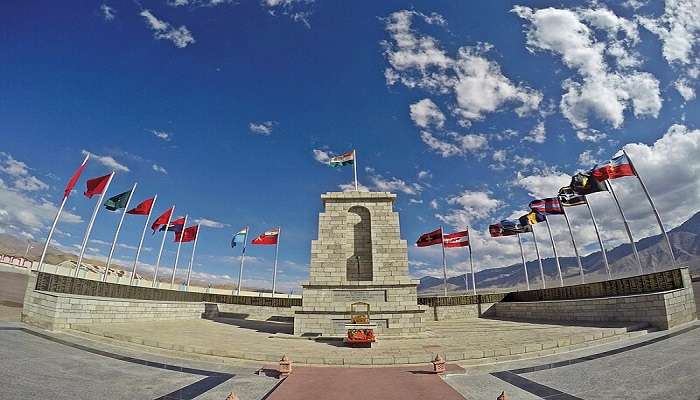
Nestled in the majestic ranges of the grand Himalayas lies the testimony of the courage of the Indian soldiers who have laid their lives in the service of the nation, Hall of Fame, a tribute to the brave soldiers of India. Situated on the Leh Kargil road, this structure not only tells the story of the bravery of Indian soldiers on the battleground of Kargil but also stands in the memory of all the soldiers who gave up their lives to ensure the top-notch safety of their countrymen. The place also features Ladakh’s customs, traditions and sanctity.
Essential Information About The Hall Of Fame
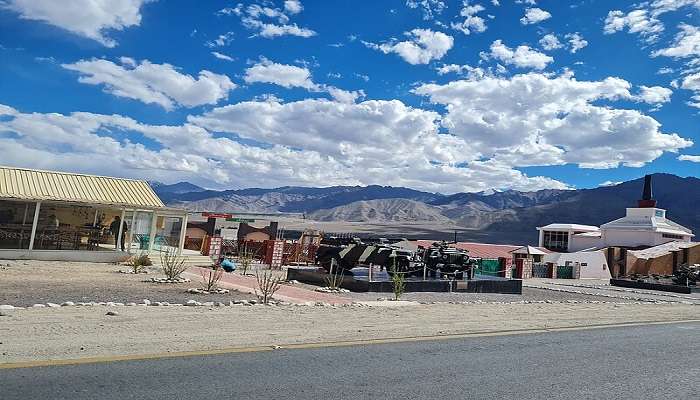
On the tough terrain where the very survival is a challenge for humans, the brave soldiers of India face it every day and fight with valour when their duty calls. The Hall of Fame speaks for all those soldiers whose voices may not be heard by their own countrymen, but the tales of their valour will not be hidden; their tales of valour will be inscribed in the walls and hearts of every Indian. The Hall of Fame in Leh is a two-storey building with multiple sections commemorating different aspects of the story, the tale of the battleground of Kargil. This war epitomises valour, sacrifice, and glory that every Indian remembers. On the upper floor of the Hall of Fame, built in the shape of a pyramid, is the OP Vijay Gallery, which features the arms and ammunition used in the legendary war of Kargil and also the weapons captured during the war. Another section on the same floor features the apparel and amenities used by the Indian Army in the challenging terrain of Siachen.
The photos displayed in this section give a glimpse of the Indian Army’s life in high-altitude Siachen, including their accommodation, training, and posts. This glimpse makes one realize what it takes to protect the nation. On the ground floor of the Hall Of Fame facilitates a projection room that plays the story of “Operation Vijay”, a story of sacrifice, sacrifice of not only their lives but of those million moments that were written in letters but not fulfilled, sacrifice of the aspirations of their families. That is what the letter “The Last Post” of Captain Vijyant Thapar signified. In another section, a wall is solely dedicated to all the brave soldiers whose determined actions led to the safety of millions of Indians. The wall inscribes their names and photos so visitors can get acquainted with these brave protectors of India. The section on the ground floor is dedicated to the culture, biodiversity and customs of the chaste land of Ladakh, which witnesses not only holiness but also valour and sacrifice, bestowing pristine sanctity upon the land.
Must Read: Trekking In Ladakh
The Light And Sound Show Of Hall Of Fame
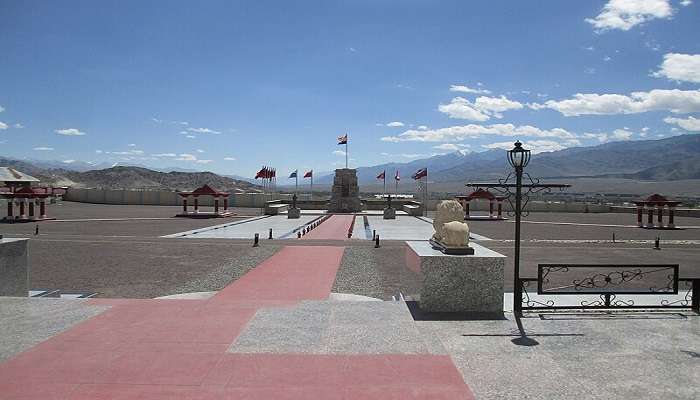
Leh – Ladakh is a land of culture, divinity, sacrifice and unabashed valour. This land of Ladakh has tales of gallant soldiers armed with nothing but pride on their faces. This pious land of Ladakh has been wrenched with the blood of the warriors, and this land of Ladakh has witnessed these tales turn into legends of valour. The legends passed from soldier to soldier with proud smiles and grief in their hearts, as with valour comes sacrifice. This is the story that this six-dimensional Light and sound show of the Hall of Fame narrates – the exceptional tales of the Indo-Pak Wars from the land of Leh Ladakh when the sun sets and the dark veil of night sets in. The Hall of Fame also has a souvenir shop that sells small souvenirs for you and your family to remind you of this land of culture, sacrifice and valour – this land of Ladakh.
Charges – Rs 25 per person
Timings – 9:00 am to 1:00 pm and 2:00 pm to 7:00 pm
Biking On Leh-Kargil Road
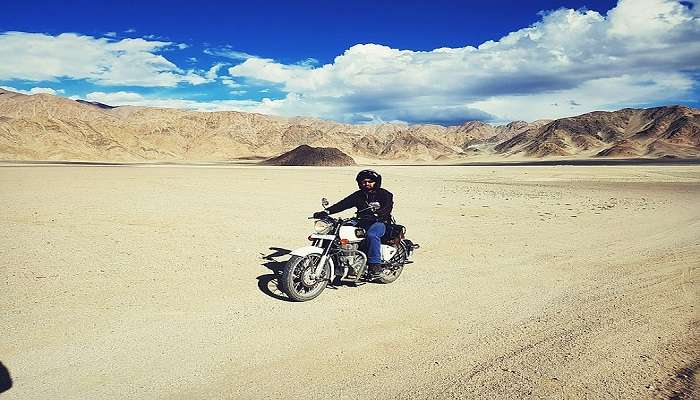
Biking on the undulating terrains of the Himalayas is an enchanting experience where one feels an unmatched thrill amidst the glory of the snow-capped mountains. The Himalayas hide in themselves stories that are long forgotten, stories that shape the lives of the people of the Himalayas, stories that can be found on the untrodden of these magnificent mountains. And a bike on the rough terrain provides just that. Not only do the rides cover the major attractions of the place, but they also cover the places that provide one with a true insight into the place with the visit to the place that is the definition of courage – Kargil.
Charges – Rs 20,000 onwards
Timings – All Day
Suggested Read: Ladakh Travel Tips
Places To Visit Near Hall of Fame
Here are the multiple places to visit on your vacation in Leh Ladakh to get a mesmerising view.
1. Spituk Monastery
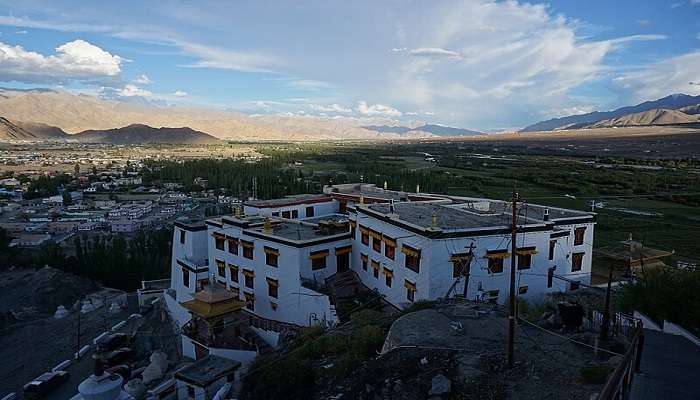
Situated about 18 km from the Hall Of Fame is the 11th-century Spituk Monastery on Srinagar Road. Perched on a hill beneath the glory of the snow-capped heavenly Himalayas, Spituk Monastery offers ethereal views of the river Indus. Founded by Od-de, the elder brother of Lha Lama Changchub Od, this monastery is the land of the order of Tsongkhapa. Tsongkhapa was a Tibetan monk, philosopher and tantric yogi whose determined action led to the formation of the Gelug School of Tibetan Buddhism. His teachings still live within the walls of Spituk Monastery. Spituk translates into exemplary, which is how it got its name. In the 11th century, when Richen Zhangpo visited the chaste land, he prophesied that an exemplary religious community would be housed there, and so it did. Today, Spituk Monastery is home to 100 monks and is revered in Ladakh for its possession of a giant statue of Kali, revealed in their festival, the Gustor Festival.
Charges – Rs 30 per person
Timings – 7:00 am to 6:30 pm
2. Gustor Festival
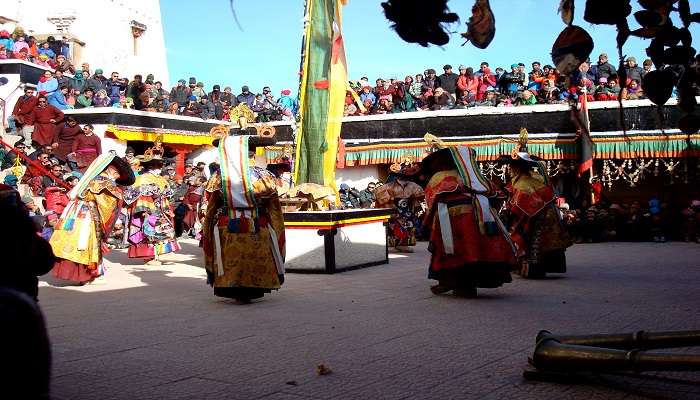
Gustor Festival is a festival of peace and prosperity celebrated in the magnificent premises of Spituk Monastery. The festival holds a special place in the heart of every Ladakhi as the Gelug Pa Order of Tibetan Buddhism, founded by the revered Tsongkhapa, is commemorated on this auspicious day. During this time of the year, the valley brims with the vibrancy of colour and culture as the monks put on colourful garbs and dance to the melodious local tunes. The mask dance, also known as Chams, is the major attraction of the festival, where monks disguise themselves as different deities and perform soul-soothing prayers. During this festival, the statue of Kali is presented and worshipped by the monks. The festival celebrates brotherhood with prayers, music and wonderful cham dances. Also, during this time, the monks hold a perfect get-together, filling the valley with the fragrance of integrity. The festival, celebrated on the 28th and 19th day of the 11th month of the Tibetan Calendar, ends with the burning of an evil effigy that depicts the triumph of good over bad.
Charges – None
Timings – 5:00 am to 9:00 pm
Suggested Read: Offbeat Places In Ladakh
3. Leh Royal Palace
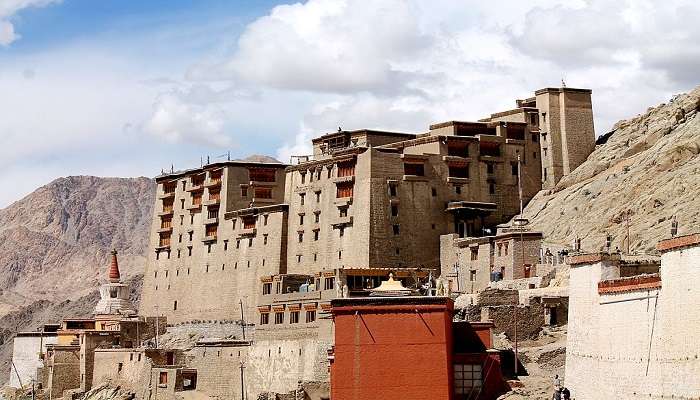
Situated 5km from the Hall of Fame museum, Leh Royal Palace is the epitome of architectural dexterity beneath the grandeur of the Zanskar Range. With its vast collection of jewellery, utensils and thangka or Tibetan paintings, Leh Royal Palace is the storehouse of the legacy and royalty of the Namgyal Dynasty. Built in the 1600s by the lion king Sengge Namgyal, the palace had to face the consequences of the attacks of the attacking Dongri forces, which led the Royal Namgyal family to shift to the Stok Palace. However, the place now under the Architectural Survey Of India still holds the legacy of the Namgyal Dynasty.
Charges – Rs 15 per person
Timings – 8:00 am to 5:00 pm
4. Galdan Namchot Festival Of Leh
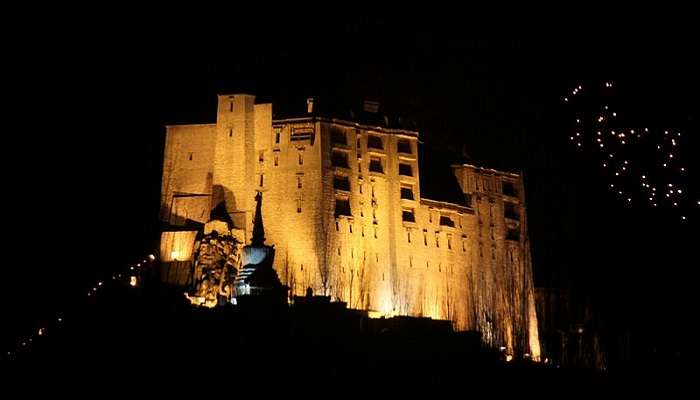
Celebrated to commemorate the birth and Buddhahood of the famous Tibetan philosopher, monk, and tantric yogi Je Tsongkhapa, the Galdan Namchot Festival is celebrated under the Leh Royal Palace every year in the twelfth month of the Tibetan Lunar Calendar. This festival also celebrates the beginning of Ladakhi New Year. The markets of Leh thrive during the festival, and all of the Ladakhi are in the celebration with full gusto. Cham dances are an important feature of the festival.
Charges – None
Timings – 5:00 am to 9:00 pm
Suggested Read: Manali To Leh Road Trip
5. Shanti Stupa
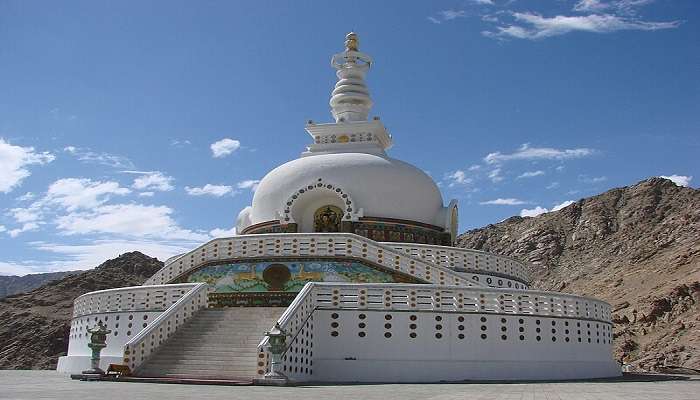
Built as a symbol of peace, the white-domed Buddhist Shanti Stupa stands on the hilltop of Changspa in the Leh district of Ladakh. The stupa holds great religious importance as it contains relics of Buddha at its base, enshrined by the Dalai Lama. The Shanti Stupa, nestled in the Himalayas’ grand ranges, offers visitors ethereal views and is located just 5 km from Leh City. The Shanti Stupa is special in itself as it covers and depicts various stages in Buddha’s life, making it the perfect visit.
Charges – None
Timings – 5:00 am to 9:00 pm
Best Time To Visit
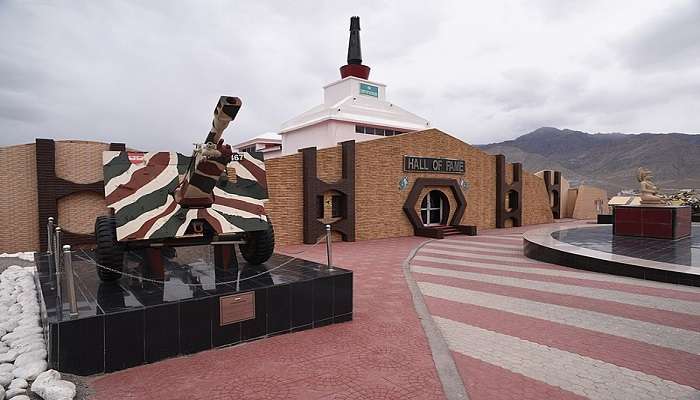
When the clear skies complement the beauty of the grand Himalayas, it is a sight that will engrave in your heart for quite a while. However, to experience the best of the Himalayas, one needs to visit it during the best weather conditions. Therefore, the best months to visit the place are from May to October, when the skies are clear and the weather is pleasant, offering the visitors ethereal views of the snow-capped Himalayas.
Further Read: Monasteries In Ladakh
This land of Leh and Ladakh harbours not only the tales of Gods themselves but also our brave soldiers’ exemplary tales of valour and sacrifice. The Hall of Fame in Leh District commemorates the stories within its walls with immense pride. Book your trip to Ladakh and experience the legends of valour against the backdrop of the Ethereal Himalayan range.
For our editorial codes of conduct and copyright disclaimer, please click here.
Cover Image Credit : Vickey Chauhan for Wikimedia Commons
Frequently Asked Questions About Hall Of Fame
What is the history of the Hall of Fame?
Hall of Fame is a museum built in memory of the soldiers who gave away their lives in the Kargil war with Pakistan. The museum is built and maintained by the Indian Army.
Who built Leh Palace in Ladakh?
King Sengge Namgyal built the Leh Royal Palace in Ladakh. Also known as Lhachen Palhkar, the palace's construction began in the 1500s and was completed in the 17th century.
What is the best time to visit Leh?
One can get ethereal views of the mountain ranges of the Himalayas in Leh from May to October, and these months are the best months to visit the Palace. The weather is pleasant during this time.
What are some of the delicacies of Leh?
When in Leh, you should not miss the authentic Ladakh food. Some of the dishes that you must try are Momos, Sky, Thupka, and Gur Chai, which are some of the local delicacies of Leh.
When can one watch a light and sound show in the Hall Of Museum?
The Hall of Fame's light and sound show narrates the stories of the Indo-Pak Wars. It can be witnessed during the evening in the Hall of Fame.
People Also Read:
Things To Do In Ladakh Offbeat Places In Ladakh Homestays In Ladakh

Unveil the hidden treasures of the globe and turn every travel dream into reality. As a Content Writer, I am passionate enough to craft stories from ancient wonders to modern marvels. My words paint the picture-perfect itinerary for unforgettable experiences. Let my words be your trusted guide to immerse in the diverse culture and discover the beauty of the unknown.











